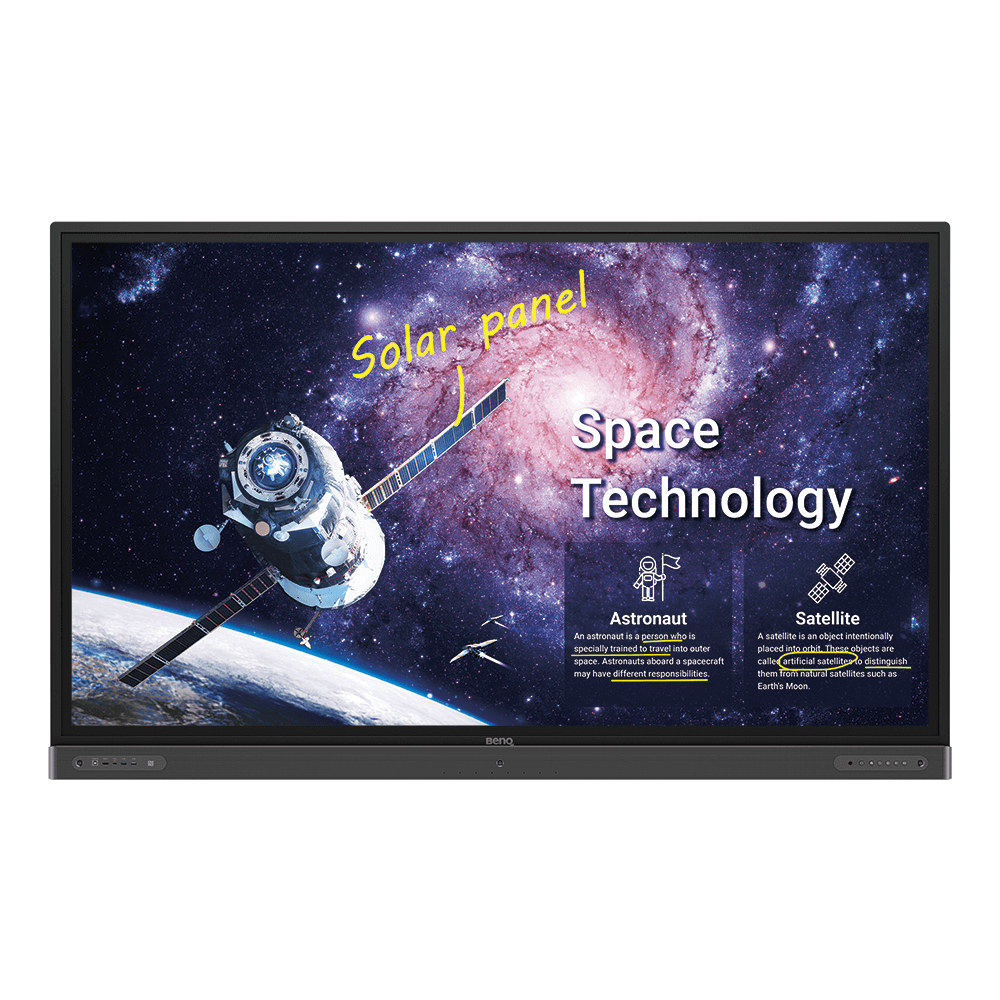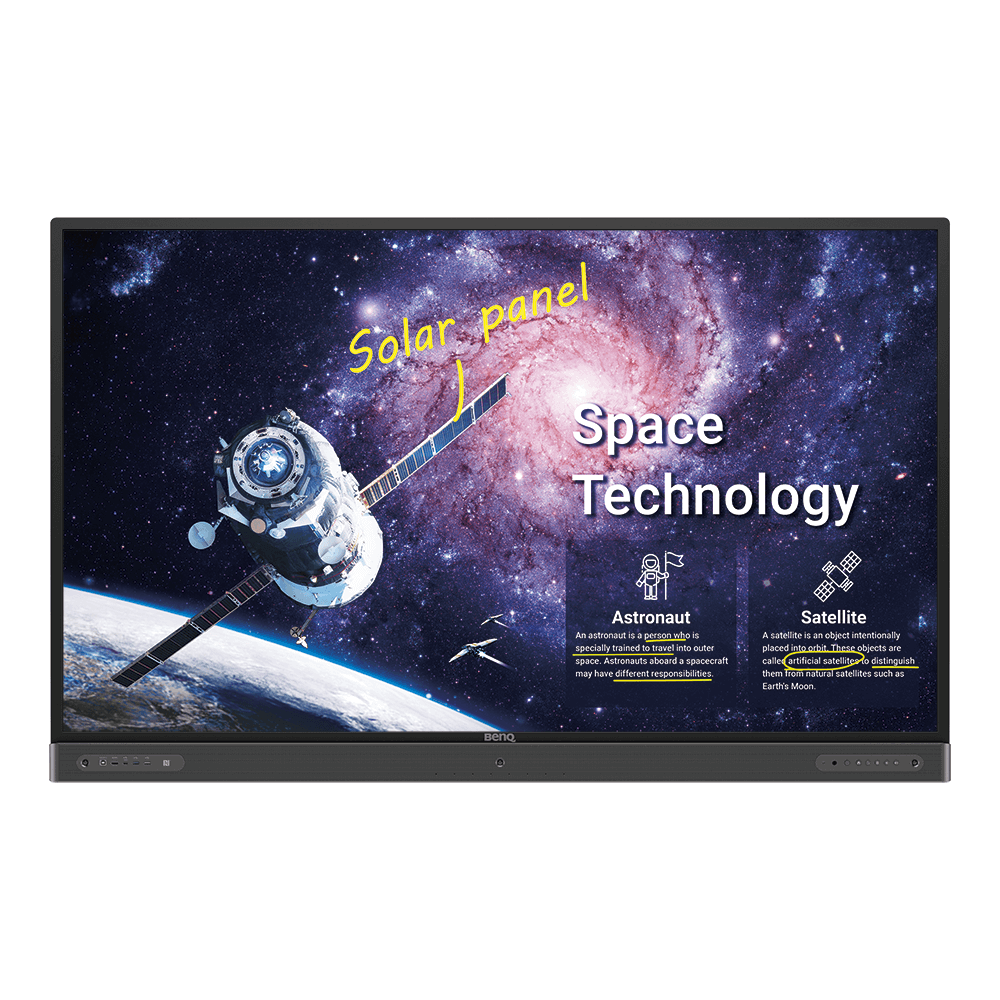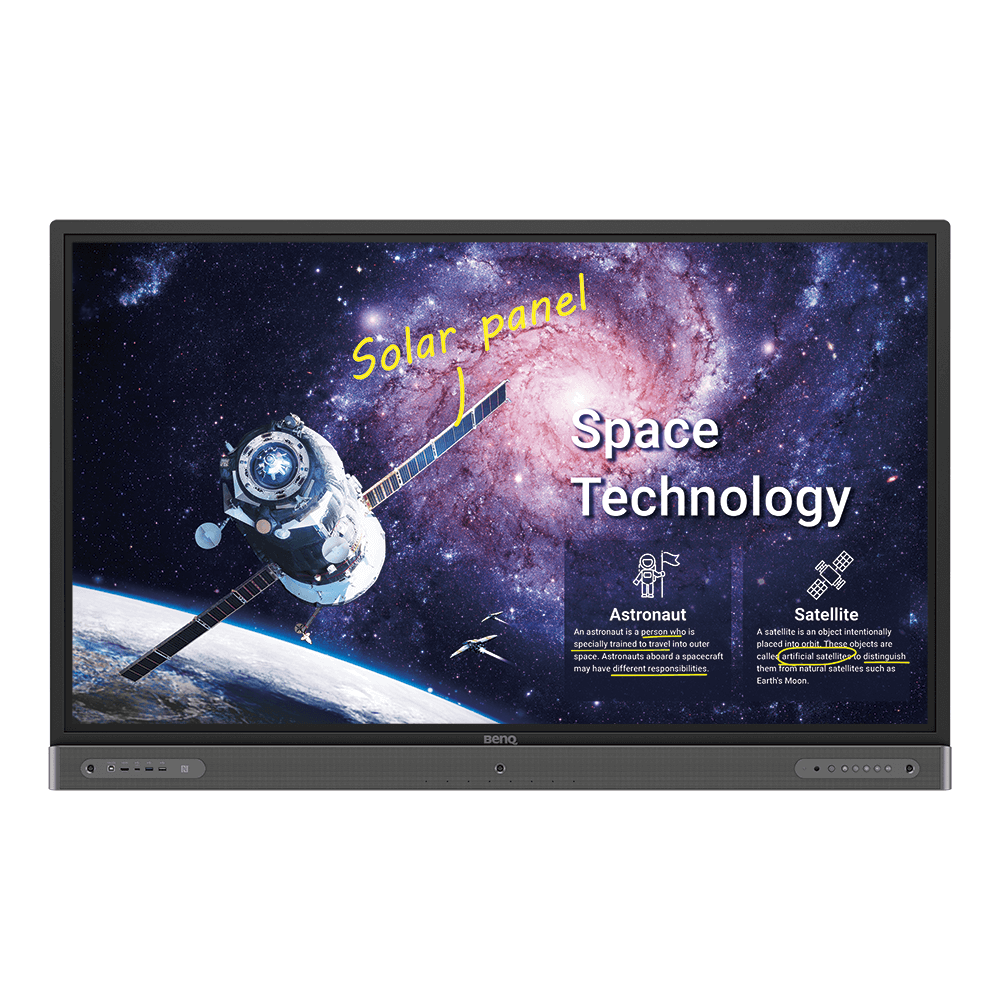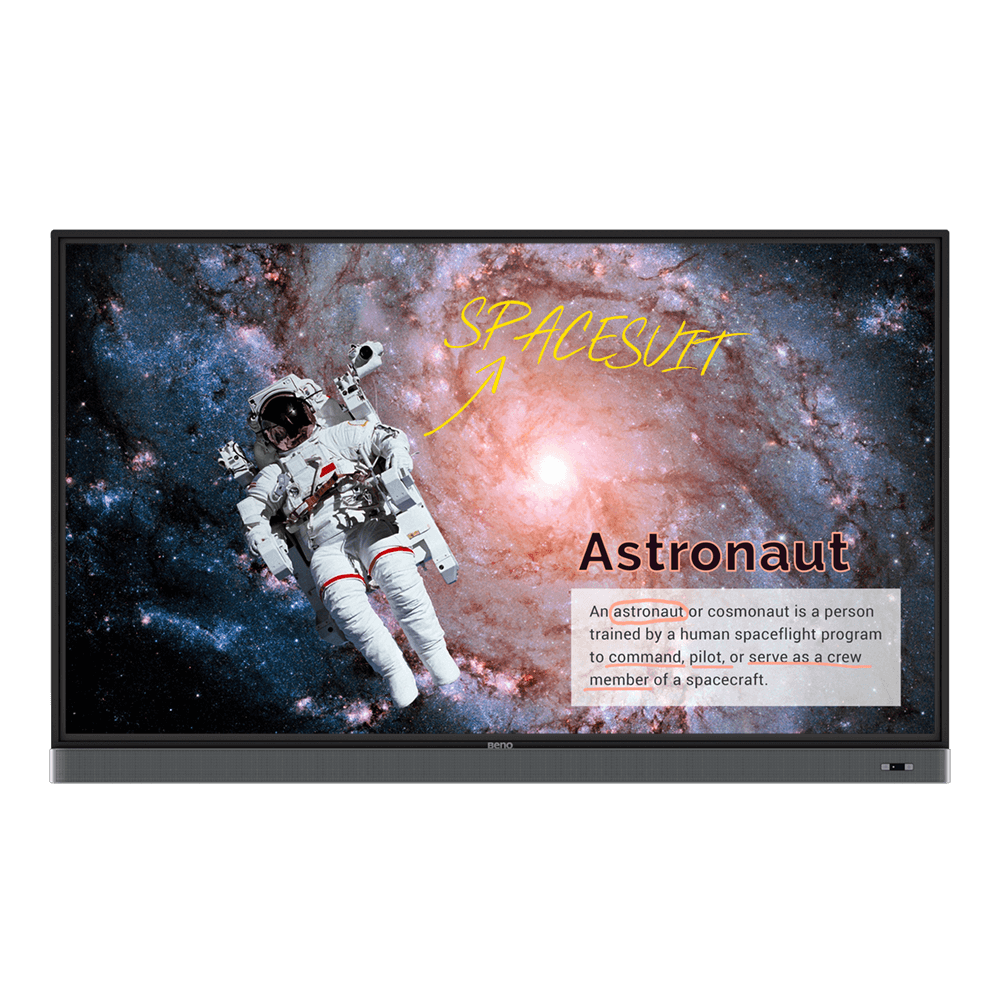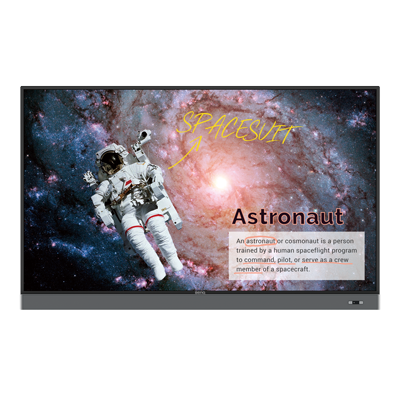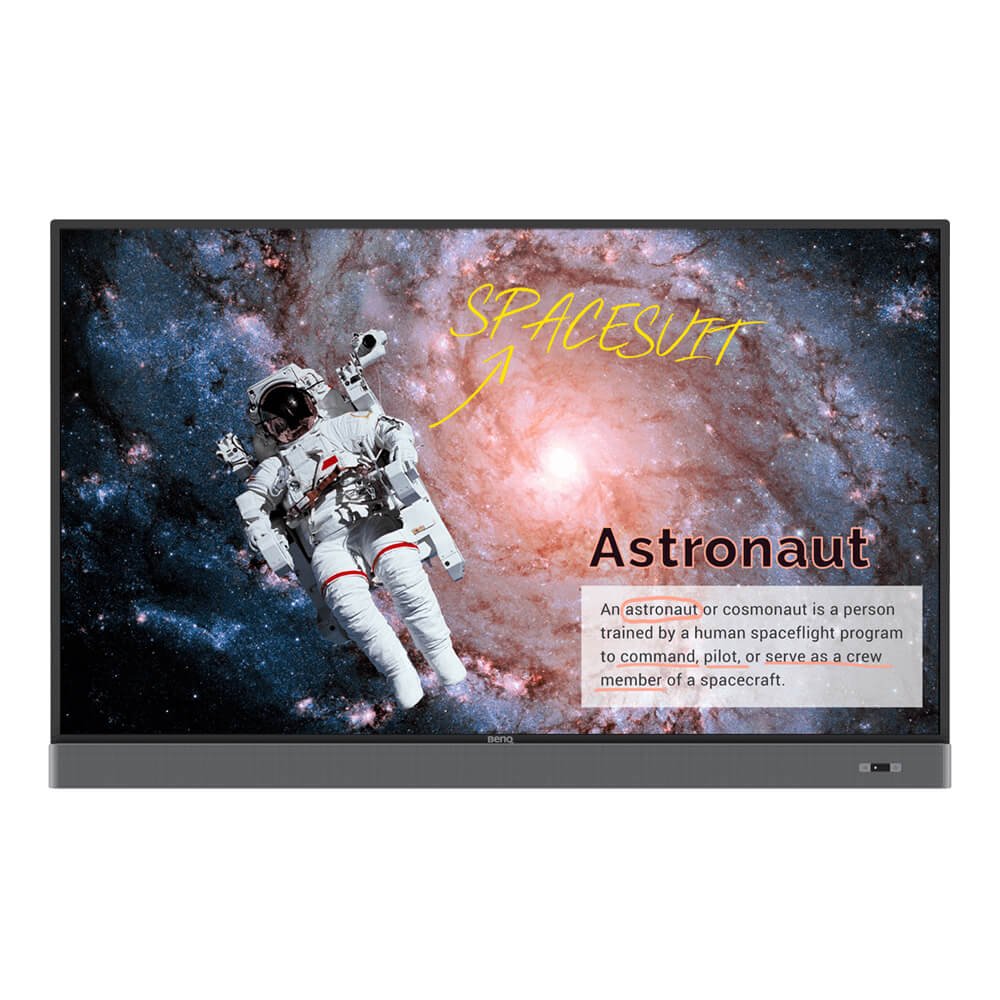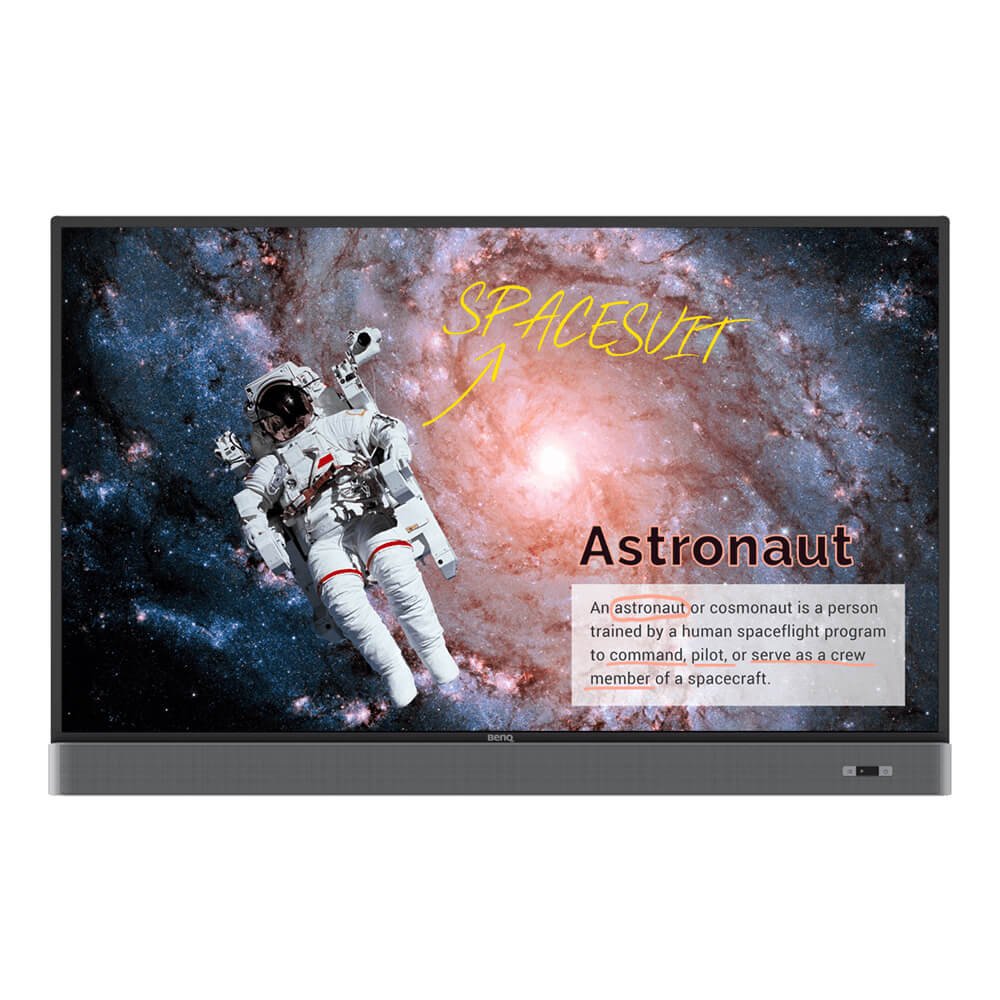SMART Board 6000S vs. BenQ Board RP Series
- BenQ
- 2021-07-02
Two of the most feature rich classroom interactive boards go head to head. Which one is best for your classroom?
BenQ and SMART Technologies are two of the largest education display companies in the world. For years SMART was a market leader in interactive whiteboards, and BenQ was the world leader in DLP powered education projectors. As schools transition from interactive whiteboards to interactive displays that don’t require a PC, IT managers are often deciding between these two models that are positioned at the top of each company’s line. We will try to provide a fair and honest comparison between these two products.
Here are the key elements to compare:
A bright display that is easy to read is a key feature in any classroom display. Brighter displays with high contrast ratios are easier for students to read – especially from the back of the room. The BenQ RP display is 22% brighter than the equivalent size of the SMART 6000S, and has very high contrast ratios that are ideal for better visibility when students are sitting farther from the display for social distancing.
Specification |
BenQ Board RP02 – 75” |
SMART 6000S - 75” |
Specification Brightness | BenQ Board RP02 – 75” 450 nits | SMART 6000S - 75” 350 nits |
Specification Dynamic Contrast | BenQ Board RP02 – 75” 40,000:1 | SMART 6000S - 75” Not Specified |
Specification Expected Life | BenQ Board RP02 – 75” 50,000 hours | SMART 6000S - 75” 50,000 hours |
Both of these Interactive displays are designed for hybrid classrooms. Unlike a traditional interactive whiteboard, these displays don’t require a PC to be connected – and both can be directly connected to a teacher’s SMART Notebook computer. Each display has a powerful Android setup with whiteboarding software with common features such as screen dividers, wireless casting, and the ability to annotate on a MS Office file or other program. So what are the biggest differences?
Touch Sensor Technology
To better simulate the experience of using a real marker, BenQ, SMART, and Promethean interactive displays use advanced IR touch systems that enable a near-instant response and a smoother, more intuitive writing experience. The BenQ system uses a system that is optically bonded to the glass called “FineIR,” while the SMART version of this is called HyprTouch, which has multiple versions of sensitivity. The SMART 6000S Series is less sensitive compared to their corporate SMART 7000 Series.
Whiteboard Object Recognition
Both SMART and BenQ displays recognize 20 points of touch using the Android systems built into the display, palm eraser recognition, can recognize inputs from both pens and fingers, and can convert handwriting to text. Both companies also have unique innovations in object recognition for the classroom that separate them from generic interactive displays.
The BenQ RP has a special “Paintbrush” mode that will recognize the width of a real paintbrush (from tiny to very wide) being used on the screen – enabling the panel to be used for calligraphy or writing variable-width non-Latin characters such as Kanji or Hebrew. This kind of flexibility is essential to communicating thoughts and ideas that a pen alone simply cannot. The SMART 6000S has special object recognition software to recognize certain “stamps” or cubes that can be used to place pre-determined shapes on the board.
In-Person vs Cloud Whiteboarding
Both SMART and BenQ interactive displays are more than capable touch panels for in-person learning. But now cloud-based whiteboarding is critical to student performance to enable teacher and student flexibility for remote and hybrid learning.
BenQ developed the world’s first dynamic cloud whiteboarding system in a classroom display. With the teacher in the classroom, students can interact with the board in real-time via their device at home, making it easy for remote tutoring or coaching. For example, the teacher can send a link or a QR code and broadcast directly from the board to a student's Chromebook or iPad logged into their home network. The teacher can also allow the student to interact directly on the board with the device with a single tap on the whiteboard – say to allow the student to solve the math problem on the board. Since the system is network and software agnostic, it enables unprecedented flexibility to both teachers and students that complement other classroom systems such as Zoom or Teams. Powerful cloud whiteboarding features like this are why BenQ’s RP series is the world’s most awarded education touch display. There are no additional licensing fees for this software for the life of the display.
SMART doesn’t have a native cloud whiteboarding feature in the 6000S, but offers a SMART Learning Suite on a separate PC where students can access a lesson online. This system has a canvas application, but can cost a school district $59 per year per display. According to the COSN TCO Calculator, this cost should be factored into your total cost of ownership calculation for the expected life of the display.
Whiteboard Functionality |
BenQ Board RP02 |
SMART 6000S |
Whiteboard Functionality Touch Sensor | BenQ Board RP02 Fine IR -Zero Bond Optical Touch Sensor | SMART 6000S HyprTouch |
Whiteboard Functionality Shape Recognition | BenQ Board RP02 Palm Eraser Paintbrush width recognition for calligraphy / non-Latin Characters | SMART 6000S Palm Eraser SMART Stamps |
Whiteboard Functionality Cloud Whiteboarding | BenQ Board RP02 Included at no cost | SMART 6000S 1 Year Subscription |
Research at the University of Albany showed that students who use to recorded lessons do substantially better than those who don’t. So what should you look for to ensure your teachers can easily store and share their lessons?
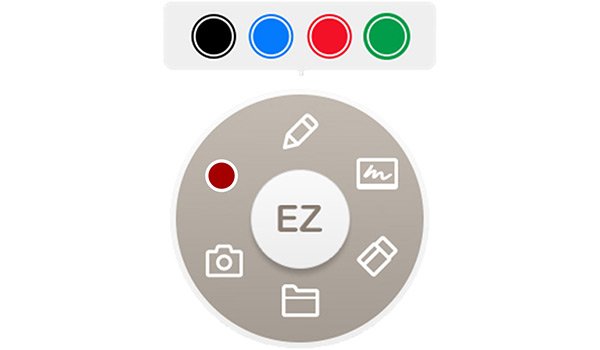
A two finger tap on the screen enables BenQ's Floating Tool to instantly start recording
The BenQ RP interactive display enables instant recording directly on the board from any application with a single two-finger tap. This intuitive user interface enables a teacher to record any lesson – without having to open another application. Just tap the screen and hit record – that simple. These lessons can be recorded on the display storage – or on a cloud / network drive using Tap ‘N Teach connected technology.
The SMART 6000S Series doesn’t have screen recording as part of the display, but requires the use of SMART Notebook software on a computer to record a lesson. Teachers will need to switch to their PC, open the SMART Recorder app, configure the resolution and audio settings and use the application. Since there is no microphone on the SMART 6000S, teachers will also need to configure the application for a microphone before using.
Array Microphone and Speakers
Teachers have known the most effective lessons combine both visual and audio information. So how well do the BenQ RP and SMART interactive displays capture the teacher’s voice?
The BenQ RP series display comes with an 8-microphone array built-in capable of recording the teacher’s voice from 15 feet away. This system has advanced sound recognition software similar to a smartphone that cancels out background noise and “follows” the teacher as they move around the room.
Unlike other interactive displays, such as the Viewsonic Series 52, the SMART 6000S does not come with any microphone. This means a school will need to make an additional investment on audio capture technology for hybrid learning such as such as this array microphone from Nueva, which enables the microphone to be moved with the display.
Both displays feature quality high powered stereo speakers, but the BenQ RP series also adds a subwoofer for better low voice clarity and more accurate reproduction of lower ranges in music.
Classroom and Lesson Recording |
BenQ Board RP02 – 75” |
SMART 6000S - 75” – 75” |
Classroom and Lesson Recording Recording method | BenQ Board RP02 – 75” Simple Two Finger Tap from any application | SMART 6000S - 75” – 75” The teacher must open and set up the app to record |
Classroom and Lesson Recording Integrated Microphone | BenQ Board RP02 – 75” 8 microphone array built-in | SMART 6000S - 75” – 75” None |
Classroom and Lesson Recording Speakers | BenQ Board RP02 – 75” 32 Watt Sound bar 15 Watt Subwoofer | SMART 6000S - 75” – 75” 40 Watt Sound bar
|
In 2020, the COVID-19 pandemic created a new paradigm for schools and elevated the need for student and teacher safety. BenQ has been integrating key safety features into their displays since 2017, and the latest models from BenQ RP Series and SMART have a variety of important safety features on each display.
Tempered Glass with Anti-Glare coating
To keep the panel from being scratched, manufacturers can purchase harder glass. BenQ has a 9 out of 10 hardness rating, while 7 out of 10 is typical with lower priced displays. SMART does not disclose the glass hardness rating in their specification sheet or brochure for the 6000S.
Anti-Microbial Coatings
Antimicrobial coatings are used in surgical lighting and other sensitive areas to keep germs from growing on the display. This feature has been available from BenQ since 2018 and is also available on other brands of interactive displays. These anti-microbial coatings must be carefully applied and baked onto the glass. The BenQ RP series has been certified by Europe’s TUV against the five most common types of bacteria, including e. Coli, Salmonella, and pneumonia. The BenQ display is also certified as classroom safe and toxin-free under Japan’s SIAA standard tests for potential risks such as long-term touch and oral toxicity.
Other classroom displays such as the Newline RS+ have a lower level of antimicrobial coating (with fewer certifications), but the SMART 6000S does not offer any antimicrobial protective coatings on the glass.
Classroom Air Quality
Recent studies have even demonstrated that higher levels of CO2 in a room cause people to become drowsy and pay less attention. Companies such as 3M have been working hard to improve the quality of the air in classrooms using advanced filters. But can teachers and facilities managers tell if it is working? The BenQ RP interactive display will monitor temperature, humidity, and CO2 via a sensor that alerts the teacher it’s time to open a window or take other action. BenQ even takes this approach a step further, and will also alert the teacher if levels of dust and particulate matter in the room are dangerously high.
Teacher and Student Safety Features |
BenQ Board RP02 |
SMART 6000S |
Teacher and Student Safety Features Tempered Glass Hardness Level (MOHS) | BenQ Board RP02 9 | SMART 6000S Not Specified |
Teacher and Student Safety Features Antimicrobial Glass Germ Certifications | BenQ Board RP02 TUV Certifications (5) SIAA Toxin Free | SMART 6000S No Antimicrobial glass available |
Teacher and Student Safety Features Blue Light Protection | BenQ Board RP02 Yes TUV Certified | SMART 6000S No |
Teacher and Student Safety Features Flicker-Free Backlight | BenQ Board RP02 Yes TUV Certified | SMART 6000S No |
Teacher and Student Safety Features Temperature / Humidity | BenQ Board RP02 Yes | SMART 6000S Yes |
Teacher and Student Safety Features Air Quality Monitor | BenQ Board RP02 CO2 Dust / Particulate (2 sizes) | SMART 6000S No |
Managing a large number of classroom interactive displays requires an effective remote management software system or Device Management Systems (DMS). Both BenQ and SMART offer systems that permit admins to push settings, updates, apps, and campus-wide text messages to any or all boards in their network.
The BenQ DMS has the ability to broadcast graphics as well as video streams to the display – perfect for morning announcements. In addition, for schools who have both projectors and interactive displays, the BenQ DMS will enable scheduling and control of nearly any projector in addition to the displays – making it easier for IT to manage their facilities. There is also no subscription fees with any BenQ display.
Device Management System |
BenQ DMS & X-Sign |
SMART Remote Management |
Device Management System Interactive Display Control & Monitoring | BenQ DMS & X-Sign Yes | SMART Remote Management Yes |
Device Management System Remote App Management | BenQ DMS & X-Sign Yes | SMART Remote Management Yes |
Device Management System Multimedia Message Broadcast | BenQ DMS & X-Sign Yes | SMART Remote Management Text Only |
Device Management System Task Scheduling | BenQ DMS & X-Sign Yes | SMART Remote Management Yes |
Device Management System Display Analytics | BenQ DMS & X-Sign Yes | SMART Remote Management Yes |
Device Management System Projector Support | BenQ DMS & X-Sign Yes – including Epson, NEC, and Maxell projectors | SMART Remote Management No |
Device Management System License timeframe | BenQ DMS & X-Sign Lifetime of Display | SMART Remote Management Not Specified |
For Teachers - Account Management and Logging-In
Both the BenQ RP and the SMART Board 6000S can be set up to enable teachers to securely log into the display and access network and cloud files directly from the display. However, there is a substantial difference between the two and the BenQ system makes is both easier to setup for the IT manager – and more secure for the teacher.
Here’s how it works:
The IT manager creates a teacher account in BenQ’s Account Management System software database by linking it to their Active Directory infrastructure. This enables the teacher to personalize their display – but restrict other settings – such as changing the network or installing an age-inappropriate apps loaded on the panel such as FaceBook being on a first-grade teachers' board.
The best part about Tap N’ Teach is how easy and fast it is for a teacher to use. Using the same secure technology used for Apple Pay– a teacher simply tap’s the panel with their card or badge – and in a few seconds, the display is personalized for that teacher, complete with background, apps, and network connection so the Google, Microsoft OneNote, and school network drives are automatically connected. When they are finished – they tap the display again and the display returns to its generic state. Any teacher can use any panel at any time with full access to their lessons – without a PC.
By contrast, the SMART 6000S requires the teacher to manually sign-in on the display – typing in their password on the screen. If the teacher has a SMART account in order to use the software, then the system will connect to the Google drive and other resources. This could make it difficult if a school wants to use a competitive curriculum in the future to improve student performance.
Teacher Login and Cloud Access |
BenQ Tap ‘N Teach |
SMART6000S |
Teacher Login and Cloud Access Access Google Drive from the panel | BenQ Tap ‘N Teach Yes | SMART6000S Yes |
Teacher Login and Cloud Access NFC Card Secure Login | BenQ Tap ‘N Teach Yes | SMART6000S No |
Teacher Login and Cloud Access QR Code Secure Login | BenQ Tap ‘N Teach Yes | SMART6000S With Companion App |
Teacher Login and Cloud Access Active Directory support for Account Management | BenQ Tap ‘N Teach Yes | SMART6000S No |
So which interactive board is better for me – BenQ RP or SMART Board 6000S?
While both models share similar features such as 4K resolution, excellent whiteboarding and annotation software, wireless screen mirroring, and centralized management software, understanding the key differences will help you decide which brand of interactive touch display will be right for your classroom.
It’s important to do research and consult important stakeholders before deciding which board your school district should adopt. But there are some major advantages that BenQ brings to the table that can make a difference to a school that might want more flexibility in its curriculum. When deciding on your chosen solution, consider the following differences:
- The BenQ display has advanced IR sensors that are optically bonded to the glass and has advanced object recognition that allows the use of a generic paintbrush to apply a variable-width stroke for drawing calligraphy or Kanji characters.
- The BenQ display has an integrated cloud whiteboarding software ecosystem that works without any subscriptions or need for a PC connection
- The BenQ has more advanced classroom safety features, including anti-microbial glass, certified blue light filters, and a flicker-free screen that helps protect the user’s vision.
- BenQ’s Tap ‘N Teach NFC technology enables instant, wireless, secure teacher login – and even integrates with Active Directory. With a single tap, a teacher can transform any board on campus into their personalized interactive board in under 10 seconds.
- BenQ Device management software allows school IT admins to manage BenQ displays, projectors, and even equipment from displays from legacy brands including Epson, NEC, Hitachi, and Casio – without requiring a subscription
- BenQ panels are designed and tested to run a wide variety of classroom education curriculum including SMART Notebook, ActiveInspire, Google Classroom, Microsoft Whiteboard, and dozens of other curriculum software platforms to enable curriculum director’s flexibility to use the software they want to increase student performance.
